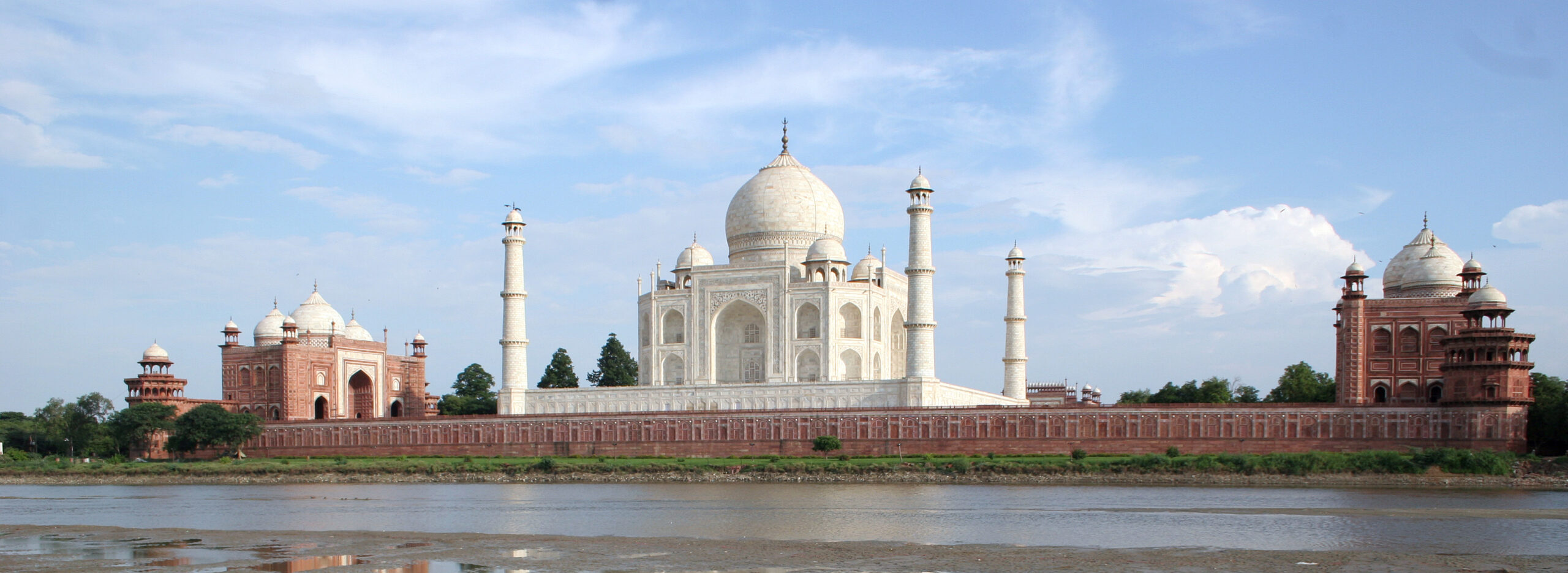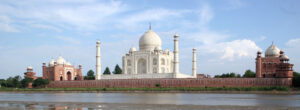
The Taj Mahal (Literally : ´´Crown of the Palace´´) is an ivory-white marble mausoleum on the south bank of the Yamuna river in the Indian city of Agra. It was commissioned in 1632 by the Mughal emperor Shah Jahan (reigned from 1628 to 1658) to house the tomb of his favourite wife, Mumtaz Mahal. It also houses the tomb of Shah Jahan himself. The Taj Mahal is an extensive complex of buildings and gardens that extends over 22.44 hectares (55.5 acres) and includes subsidiary tombs, waterworks infrastructure, the small town of Taj Ganji to the south and a ‘moonlight garden’ to the north of the river. The tomb is the centrepiece of a 17-hectare (42-acre) complex which includes A mosque, A guest house and is set in formal gardens bounded on three sides by a crenellated wall. The Taj Mahal it is one of the most famous and recognizable buildings in the world and while the large domed marble mausoleum is the most familiar part of the monument



TAJ MAHAL : MOONLIGHT GARDEN (MAHTAB BAGH)
- To the north of the Taj Mahal complex, across the river is another Charbagh garden, Mahtab Bagh
- It was designed as an integral part of the complex in the riverfront terrace pattern seen elsewhere in Agra
- Its width is identical to that of the rest of the Taj
- The garden historian Elizabeth Moynihan suggests the large octagonal pool in the centre of the terrace would reflect the image of the Mausoleum and thus the garden would provide a setting to view the Taj Mahal
- The garden has been beset by flooding from the river since Mughal times
- As a result, the condition of the remaining structures is quite ruinous
- Four sandstone towers marked the corners of the garden, only the south-eastward one remains
- The foundations of two structures remain immediately north and south of the large pool which were probably garden pavilions
- From the northern structure a stepped waterfall would have fed the pool
- The garden to the north has the typical square, cross-axial plan with a square pool in its centre
- To the west an aqueduct fed the garden
WHAT IS THE TAJ MAHAL ?
- The Taj Mahal (Literally : ´´Crown of the Palace´´) is an ivory-white marble mausoleum on the south bank of the Yamuna river in the Indian city of Agra
- It was commissioned in 1632 by the Mughal emperor Shah Jahan (reigned from 1628 to 1658) to house the tomb of his favourite wife, Mumtaz Mahal
- It also houses the tomb of Shah Jahan himself
- The Taj Mahal is an extensive complex of buildings and gardens that extends over 22.44 hectares (55.5 acres) and includes subsidiary tombs, waterworks infrastructure, the small town of Taj Ganji to the south and a ‘moonlight garden’ to the north of the river
- The tomb is the centrepiece of a 17-hectare (42-acre) complex which includes
- A mosque
- A guest house and
- Is set in formal gardens bounded on three sides by a crenellated wall
- The Taj Mahal it is one of the most famous and recognizable buildings in the world and while the large domed marble mausoleum is the most familiar part of the monument
WHY WAS THE TAJ MAHAL BUILT ?
- It was to be built in the memory of his wife Mumtaz Mahal (Literally : ´´Jewel of the palace´´) who died on 17 June 1631 – giving birth to their 14th child, Gauhara Begum
- The design was conceived as an earthly replica of the house of Mumtaz Mahal in paradise
- The distraught Mughal Emperor Shah Jahan commissioned the project upon the death of one of his favorite wives Mumtaz Mahal
- The imperial court documenting Shah Jahan’s grief after the death of Mumtaz Mahal illustrates the love story held as the inspiration for the Taj Mahal
WHAT IS THE BRIEF CONSTRUCTION HISTORY & DISTINCTIONS OF THE TAJ MAHAL ?
- The Taj Mahal was commissioned by Shah Jahan in 1631
- Construction of Taj Mahal began in 1632 AD, (1041 AH), on the south bank of the River Yamuna in Agra, and was substantially complete by 1648 AD (1058 AH)
- Construction started in 1632 and the mausoleum was completed in 1643, while the surrounding buildings and garden were finished five years later
- Construction of the mausoleum was essentially completed in 1643, but work continued on other phases of the project for another 10 years
- The Taj Mahal complex is believed to have been completed in its entirety in 1653 at a cost estimated at the time to be around 32 million rupees, which in 2020 would be approximately 70 billion rupees (about U.S. $916 million)
- The construction project employed some 20000 artisans under the guidance of a board of architects led by the court architect to the emperor, Ustad Ahmad Lahauri
- The Taj Mahal was designated as a UNESCO World Heritage Site in 1983 for being “the jewel of Muslim art in India and one of the universally admired masterpieces of the world’s heritage”
- It is regarded by many as the best example of Mughal architecture and a symbol of India’s rich history
- The Taj Mahal attracts 7 – 8 million visitors a year (almost equivalent to The Eiffel Tower in Paris)
- in 2007 – It was declared a winner of the New7Wonders of the World (2000 – 2007) initiative
- The grounds are open from 06:00 to 19:00 weekdays, except for Friday when the complex is open for prayers at the mosque between 12:00 and 14:00
- The complex is open for night viewing on the day of the full moon and two days before and after excluding Fridays and the month of Ramadan
- Foreign dignitaries often visit the Taj Mahal on trips to India. Notable figures who have travelled to the site include Dwight Eisenhower, Jacqueline Kennedy, Jimmy Carter, George H.W. Bush, George Harrison, Barack and Michelle Obama, Mark Zuckerberg, Vladimir Putin, Princess Diana and Donald Trump
- The Taj Mahal represents the finest and most sophisticated example of Mughal architecture
- Its origins lie in the moving circumstances of its commission and the culture and history of an Islamic Mughal empire’s rule of large parts of India
- Agra became a thriving riverfront garden city developed on both banks of the Yamuna
- This included the rebuilding of Agra Fort by Akbar
- Agra became a city centered on its waterfront and developed partly eastwards but mostly westwards from the rich estates that lined the banks
- The prime sites remained those that had access to the river and the Taj Mahal was built in this context, but uniquely; as a related complex on both banks of the river
WHAT ARE THE CONCEPTS, SYMBOLISM & INTERPRETATIONS OF THE TAJ MAHAL ?
GENERAL SYMBOLISM
- The Taj Mahal complex was conceived as a replica on earth of the house of the departed in paradise
- The design was conceived as an earthly replica of the house of Mumtaz Mahal in paradise
- The popular view of the Taj Mahal is as one of the world’s monuments to a great love story
- The Taj Mahal (mausoleum) at sunset. Light is a Mughal metaphor for God
TAJ MAHAL : SYMBOLISM OF LIGHT
- The constantly changing sunlight reflected from the Taj’s translucent marble is not a happy accident, it had a deliberate metaphoric role associated with the presence of god as light
TAJ MAHAL : SYMBOLISM OF SOUND
- Sound was also used to express ideas of paradise
- The interior of the mausoleum has a reverberation time (the time taken from when a noise is made until all of its echoes have died away) of 28 seconds
- This provided an atmosphere where the words of those employed to continually recite the Qu’ran (the Hafiz), in tribute and prayer for the soul of Mumtaz, would linger in the air
SYMMETRY OF THE ELEMENTS IN THE TAJ MAHAL
- Bilateral symmetry (Reflection symmetry or mirror image symmetry) expressed simultaneous ideas of pairing, counterparts and integration, reflecting intellectual and spiritual notions of universal harmony
HIERARCHY & COLOURS OF THE ELEMENTS IN THE TAJ MAHAL
- Hierarchical ordering of architecture is commonly used to emphasise particular elements of a design
- In the Taj Mahal the relative importance of each building in the complex is denoted by the amount of white marble (or sometimes white polished plaster) that is used
- In the Taj Mahal – the hierarchical use of red sandstone and white marble contributes manifold symbolic significance
- The Mughals were elaborating on a concept which traced its roots to earlier Hindu practices, set out in the Vishnudharmottara Purana – which recommended
- White stone for buildings for the Brahmins (priestly caste) and
- Red stone for members of the Kshatriyas (warrior caste)
- By building structures that employed such colour-coding, the Mughals identified themselves with the two leading classes of Indian social structure and thus defined themselves as rulers in Indian terms
- Red sandstone also had significance in the Persian origins of the Mughal empire where red was the exclusive colour of imperial tents
- The use of naturalist ornament demonstrates a similar hierarchy
ORNAMENTATION OF THE ELEMENTS IN & AROUND THE TAJ MAHAL
- Wholly absent from the more lowly jilaukhana and caravanserai areas, it can be found with increasing frequency as the processional route approaches the climactic Mausoleum
- Its symbolism is multifaceted, on the one hand evoking a more perfect, stylised and permanent garden of paradise than could be found growing in the earthly garden
- Jahan’s chroniclers who portrayed him as an ‘erect cypress of the garden of the caliphate’ and frequently used plant metaphors to praise his good governance, person, family and court
- Plant metaphors also find common cause with Hindu traditions where such symbols as the ‘vase of plenty’ (Kalasha) can be found

